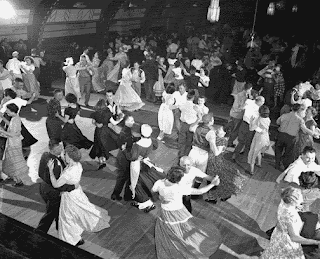I’ve been standing straighter since ballroom started. It is affecting my hunched overlook, the one meant to exude a contemplative writer lifestyle, the one that I adopt out of habit or out of a desire to imitate some sort of writerly posture. Don’t ask why I assumed that writer’s hunch. Ballroom dancers never hunch. Jolene, the dance coach, will wander the overheated gym adjusting bodies like a sculptor: pushing in bellies here, grabbing butts and hips to align them under the ribcage, slightly adjusting the minute angle of an arm connection. I’ve begun noticing when my shoulders come forward toward my chest and up towards my ears. There is a sharp pain in my left shoulder from where I’ve strained it into good posture.

Making my body dance is like making my words work on a page–making me pay better attention to the world. Nietzsche said, “Dancing in all its forms cannot be excluded from the curriculum of all noble education; dancing with the feet, with ideas, with words, and, need I add that one must also be able to dance with the pen?” Writing and ballroom have become two partners in my own dance of being alive. They challenge me to constantly practice attentiveness to the world, keeping my body and mind aware and moving as intimate partners that cannot perform without the other.
Grounded
“Grounded. Cha-cha is about being grounded,” Jolene insisted. “The problem with you two,” (here she looked away from me and towards my partner, James), “and it drives me crazy to see you doing it, is the way you both live on your toes. What are you doing up on your toes?” We shuffled our feet seriously as if it had never occurred to us to do anything as silly as stand on our toes. I didn’t look at James. But why couldn’t I stand on my toes? I liked my toes. I thought it made me seem “light on my feet.”
We tried the routine again.
“No. This dance is about your relationship with the ground. Your weight is always pulling you into the ground. Push into it, against it. Don’t try to escape it.”
We tried again. Better.
“Dana, land on your whole foot.” She leaned all her weight into my shoulders, pushing my heels onto the ground. We did the basic step. “You’re still back leading. Stop leading. Wait for my weight transfers.” We tried it again. Better this time.
This felt different. We were dancing with gravity, playfully teasing it. Keeping weight centered, pushing the ground, staying low, keeping grounded:
That’s how to look like we’re flying.
Making words fly is not easy. My poetry prof said: “I think it’s sometimes easier for the people who just fill their words with real life things and then find out weeks later what it all meant. It’s harder for someone who has abstractions and then looks at real life objects.” I’m the second writer. I am abstract. And so is my dancing. I’d like to think that abstraction is valuable for its airiness when, in reality, it is as flimsy as a carnival balloon, rising and rising until the atmosphere shreds it. I’d rather have a hot hair balloon that rises steadily, heavy with canvas and basket and fire maker and sandbags that comes down when it’s time, watching the ground and playing with gravity. Trying to leave the ground permanently just gets the writing all tripped up.
Presence and Poise
I swallowed another spoon-full of my tomato soup. A sip of water. Our dance team was on the way home from a ballroom competition.
“Jolene… can I ask you a dancing question?”
“Sure.”
“What would you say is my biggest problem?”
“Presence and Poise.”
This wasn’t what I was expecting. I thought I knew my problem. I did. I thought it was frame. I thought it was my shoulders. But no. This.
She sat quietly, eating her apple. “I’m not sure how to explain presence. It’s a way of existing on the floor. Of being seen that isn’t quite the same as performance.”
“Performance implies force, action. It isn’t that?” I asked.
She shook her head slowly, choosing words carefully. “The only way I can explain it is that your movements look lazy a lot. Very soft. And you go, you stand tall, but you still look limp.”
I nodded. I knew this.
Poise. “It isn’t a straight back. It has to do more with things that go on here.” Jolene motioned towards her core. “It’s a way of being present, controlled and controlling, of self and audience. I’m sorry this is so abstract.”
I understood this hesitancy, inability to fully explain. She sounded like a writing instructor, not quite able to put into words what is missing in a paper. Your grammar is fine. Your structure is fine. But you aren’t writing yet. Writing with the whole self and not with tools. Dancing with the whole self and not just the body. It is the skill to take the spirit, my spirit, and make my words express me. It is the skill to take the spirit, my spirit, and make it alive in my body.
I had forgotten what I have learned in writing words: technique will never bring presence or poise. Technique is the accurate expression of that center, and not the other way around, even though the learning often takes working from the outside in. The spirit of the things has to come from the inside– changing and working its way out in the body.
Boundaries
The day had been tense. I was cold as we began social dancing (salsa at a local bar). It took a while to stop shivering. My friend Robbie was the only man I knew dancing. Knowing only him was enough; he was the best dancer there.
We were dancing. It was clear he was having a very good time. And in one movement he disorients me, some unspoken line crossed. I touch the small of his back with the tips of my fingers, measuring the space between us, awkward. He turns, laughing down at me; puts his head near mine to talk over the music: “It’s fun making you blush.”
Called me out: I am blushing. I continue to blush. I had never fit in at the bar, though I had pretended otherwise. There are things I don’t know how to do, like play in response to physical playfulness. So instead, my hand held distance without thinking.
I am embarrassed. “Great. Thanks for the comment. Now I’ll be awkward the rest of the night!”
He laughs at me again. “No, you won’t.”
And he is right. I keep dancing. He teaches me more salsa moves. I am getting better and I love it.
Creating boundaries is the most natural instinct I have, as a writer and as a body. I tell myself what I can do or say and when I can do or say it. I measure interactions based on comfort level. I can skirt around the edges of discomfort.
Or I can head straight for discomfort and see where the words take me. I can learn foolishness. I can learn embarrassment. I can become a better dancer. My mother reminds me often: “The moment you feel stupid is when you are about to do it right.”
Commitment
Holding boundaries is a sign that I am afraid to fail. Ballroom, on the other hand, forces me to “commit”. I learned “commitment” when Tal, a dancer from New York, came to teach some workshops.
Neither James nor I knew how to dance Paso Doble when Tal chose us to demonstrate the routine, which consisted of struts, spins, dramatic head tosses, flying arms, intense glances, and marches across the floor. “You have to think you’re the hottest shit to ever walk out there,” Tal kept saying.
Hottest shit. Right. I laughed nervously. James shook his head.
So we tried. Tal said to try it again. And then again. We danced the routine three times before he let us stop. I was blushing, but I was doing it. Each time, my feet moved a little more confidently. I threw my head a little more. I started walking like I was the “hottest shit out there” and lost awareness for the audience. Jolene just kept saying, “Wow, they really don’t have the technique but they win on commitment alone!”
I called my ballroom friend, Jesse, that night and asked him what Jolene meant by “commitment.”
“It means that you looked like a complete idiot but went for it and didn’t care.”
Writing and writing badly can be as awkwardly visceral as learning Paso. Muscles tighten, heart rate rises. Tight neck muscles, oncoming head ache. The audience does not exist for the writing yet, but I blush to imagine them reading my sentences nonetheless. But why not just let go and let them look ridiculous? Why care? Why not let characters and words strut like mad peacocks to a dance of their own invention?
Imperfect
My first State College salsa night was a cool early summer evening; dark, lively, the way only summer evenings seem capable of being. It was dark and warm, the dense sound of talking, and the middle floor filled with people spinning and twirling.I noticed Matt, a rather good-looking fellow who had helped me in ballroom class, on the other side of the room. He nodded his head, came over to me, reached out a hand wordlessly and took me to the crowded dance floor. My back and arms were tense, trying to read his motions, trying to be a good follow, to not make him sorry he asked me to dance.
“Hey, loosen up!” he said. “This isn’t class. Loosen your hips. And look at me.”
Turning the mind off, letting it come, follow without thinking, without trying: this is dancing.
I try too hard to write. I have perfection in my head but forget that even my head probably has the wrong version of perfection. There is a bodily difference in unforced writing. Attempts at accuracy instead of spirit are felt in shaking hands, tense back, and bad following.
But in letting go, the body settles into focus and concentration, physically comfortable and content from hard word making.
Partnership
The physical stillness after dancing is the closest to silence I can imagine. Air is clearer, freer. Movement slows and the breeze feels cold and gentle. There is an awareness that comes when the body is tired from moving and moving well, from music in the ears that are now listening to its absence. The ear is trained on the body and its sound.
The quiet after writing is the same, when the work is done, the process complete. It comforts. I listen and am attentive. Mind and body move together. Mind and Body are partners. I return again to Nietzche: “Dancing in all its forms cannot be excluded from the curriculum of all noble education; dancing with the feet, with ideas, with words, and, need I add that one must also be able to dance with the pen?” And writing is the supreme partner for the mind and the dancing body. Learning is write is learning to dance. Dance is attentiveness and care, presence and performance. It is a practice. It is staying more alive.
And it is addictive, this being more alive.



